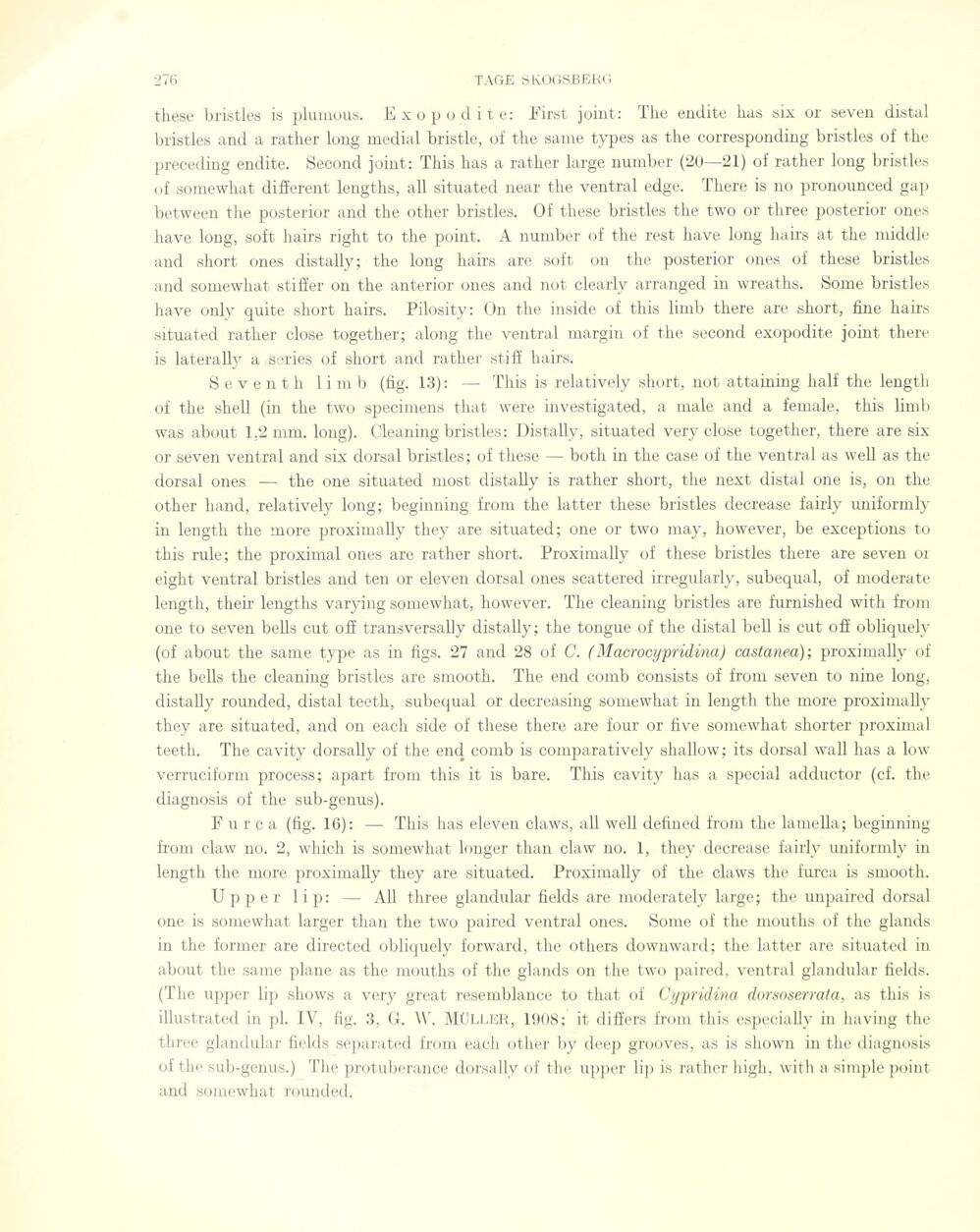
Full resolution (JPEG) - On this page / på denna sida - Sidor ...

<< prev. page << föreg. sida << >> nästa sida >> next page >>
Below is the raw OCR text
from the above scanned image.
Do you see an error? Proofread the page now!
Här nedan syns maskintolkade texten från faksimilbilden ovan.
Ser du något fel? Korrekturläs sidan nu!
This page has never been proofread. / Denna sida har aldrig korrekturlästs.
these bristles is plumous. Exopodite: First joint: The enclite has six or seven distal
bristles and a rather long medial bristle, of the same types as the corresponding bristles of the
preceding endite. Second joint: This has a rather large number (20—21) of rather long bristles
of somewhat different lengths, all situated near the ventral edge. There is no pronounced gap
between the posterior and the other bristles. Of these bristles the two or three posterior ones
have long, soft hairs right to the point. A number of the rest have long hairs at the middle
and short ones distally; the long hairs are soft on the posterior ones of these bristles
and somewhat stiffer on the anterior ones and not clearly arranged in wreaths. So me bristles
have only quite short hairs. Pilosity: On the inside of this lirnb there are short, fine hairs
situated rather close together; along the ventral margin of the second exopodite joint there
is laterally a series of short and rather stiff hairs.
S e v e n t h 1 i m b (fig. 13): — This is relatively short, not attaining half the length
of the shell (in the two specimens that were investigated, a male and a female, this limb
was about 1,2 mm. long). Cleaning bristles: Distally, situated very close together, there are six
or seven ventral and six dorsal bristles; of these — both in the case of the ventral as well as the
dorsal ones — the one situated most distally is rather short, the next distal one is, on the
other hånd, relatively long; beginning from the latter these bristles decrease fairly uniformly
in length the more proximally they are situated; one or two may, however, be exceptions to
this rule; the proximal ones are rather short. Proximally of these bristles there are seven oi
eight ventral bristles and ten or eleven dorsal ones scattered irregularly, subequal, of moderate
length, their lengths varying somewhat, however. The cleaning bristles are furnished with from
one to seven belis cut off transversally distally; the tongue of the distal bell is cut off obliquely
(of about the same type as in ligs. 27 and 28 of C. (Macrocypridina) castanea); proximally of
the belis the cleaning bristles are smooth. The end comb consists of from seven to nine long,
distally rounded, distal teeth, subequal or decreasing somewhat in length the more proximally
they are situated, and on each side of these there are four or five somewhat shorter proximal
teeth. The cavity dorsally of the end comb is comparatively shallow; its dorsal wall has a low
verruciform process; apart from this it is bare. This cavity has a special adductor (cf. the
diagnosis of the sub-genus).
Furca (fig. 16): — This has eleven claws, all well defined from the lamella; beginning
from claw no. 2, which is somewhat longer than claw no. 1, they decrease fairly uniformly in
length the more proximally they are situated. Proximally of the claws the furca is smooth.
Upper 1 i p: — All three glandular fields are moderately large; the unpaircd dorsal
one is somewhat larger than the two paired ventral ones. Some of the mouths of the glands
in the former are directed obliquely forward, the others downward; the latter are situated in
about the same plane as the mouths of the glands on the two paired, ventral glandular fields.
(The upper lip shows a very great resemblance to that of Cypridina dorsoserrata, as this is
illustrated in pi. IV, fig. 3, G. W. MÜLLER, 1908; it differs from this especially in having the
three glandular fields separated from each other by deep grooves, as is shown in the diagnosis
of the sub-genus.) The protubérance dorsally of the upper lip is rather high, with a simple point
and somewhat rounded.
<< prev. page << föreg. sida << >> nästa sida >> next page >>